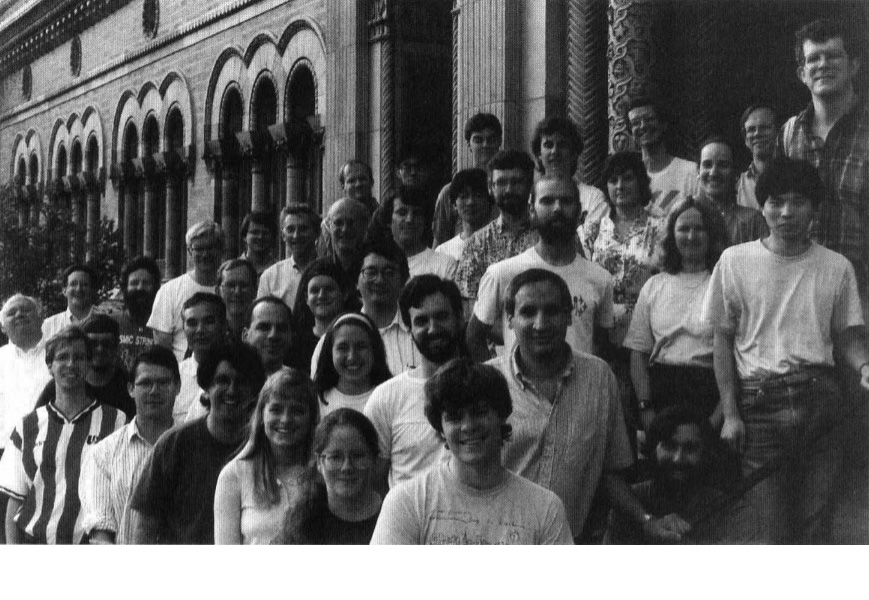Sky Survey to Map Universe
With additional grant funding and new collaborators, the Sloan Digital Sky Survey consortium is moving closer to the start of an ambitious project that will record a map of the universe with unprecedented precision. Whereas previous sky maps have charted celestial objects in two dimensions, the Sky Survey will identify hundreds of millions of galaxies, quasars, and stars, and map the locations of a million of them in three-dimensional space.
A group of astronomers, including Richard Kron and Steve Kent of Fermilab's Computing Division/Experimental Astrophysics group, conceived the Sloan Digital Sky Survey in 1988. During the course of the five-year survey, collaborators will record the red shift-an increase in wavelength that varies with velocity of a celestial body-of millions of selected astronomical objects. Knowing the red shift of an object allows astronomers to calculate its distance from the earth and hence its place in three-dimensional space. The resulting 3-D map will test basic features of the Big Bang theory of the origin of the universe.
To create the map, collaborators will use a 2.5 meter telescope located at Apache Point, New Mexico. They will operate the survey in two modes. In the first, they will use a specially adapted camera to record the direction and brightness of objects in the sky, producing a preliminary two-dimensional image. In the second mode, a pair of instruments called spectrographs measure the red shifts of a million selected galaxies and quasars, to add the third dimension, the objects' distance from the earth.
"In only three nights of observing, the new telescope will match the size of the current best red-shift surveys," said Rich Kron.
The development of the Sky Survey, including the construction of its 2.5 meter telescope and related site buildings, is progressing well, according to Don Petravick, associate head of the Computing Division On Line Systems group. "We are very pleased with the project so far," he said.
During the last two years, the collaboration has received grants from the Alfred P. Sloan Foundation and the National Science Foundation, in addition to funding from the Sky Survey's participating institutions. New collaborators from the University of Washington and the U.S. Naval Observatory have joined the Sky Survey, whose other members include the Institute for Advanced Study, the Japan Promotion group, Johns Hopkins University, Princeton University, the University of Chicago and Fermilab. Two groups from Fermilab's Computing Division, the On Line Systems group and the Experimental Astrophysics group, as well as members of the Research Division's Theoretical Astrophysics group, work on the project.
"We've done well in identifying resources for the project, but not all of the fundraising is behind us," Rich noted.
Among the Sky Survey's construction accomplishments of the past few months was installation of the monitor telescope at Apache Point. This small telescope, located next to the 2.5 meter telescope, will begin measurement of the calibration stars for the survey. Members of Fermilab's Experimental Astrophysics and On Line Systems groups recently completed the detector, camera assembly, and data acquisition systems for the monitor telescope, which is currently being commissioned.
Collaborators are very pleased with another element of the Sky Survey's apparatus, the drift scan camera, built by Fermilab astrophysicist Tim McKay and members of the Research Division's Detector Electronic Systems group. The drift scan camera serves as a prototype for the Sky Survey's camera. "We are using the drift scan camera to get a preliminary look at what the Sloan Sky Survey will actually show us. It's like using a detector prototype in a test beam for a particle accelerator experiment," Tim said.
With service buildings and housings for the telescopes finished, the group is concentrating on completing the 2.5 meter telescope. They expect to assemble the telescope on site at the beginning of May. All instruments for the telescope, including the Fermilab-created data-acquisition system, should be installed by late fall of 1995. After a period of debugging and a year of imaging the sky, the group hopes to begin creating their three-dimensional map of the universe in 1997.
Once the Sky Survey is underway, Fermilab will be the hub for all data-processing activity. As data streams in from the survey, a computing system created by Fermilab's On Line Systems group will analyze and archive the results. Under the guidance of Don Petravick and Rith Pordes, the On Line Systems group has also written a large software package to allow scientists to work with the data from the survey without traveling to the observatory. The group also has a role in integrating and testing software that scientific collaborators deliver to the project. The Computing Division is also evaluating the purchase of the computing system that will analyze the data as it comes from Apache Point.
Don points out that much remains to be done to complete the data processing system and a data base system for the Sky Survey, but he remains optimistic. He credits the success of the project so far with the teamwork of the collaboration. "We are all having a good time and are starting to deliver real things, and that makes us all happy."




